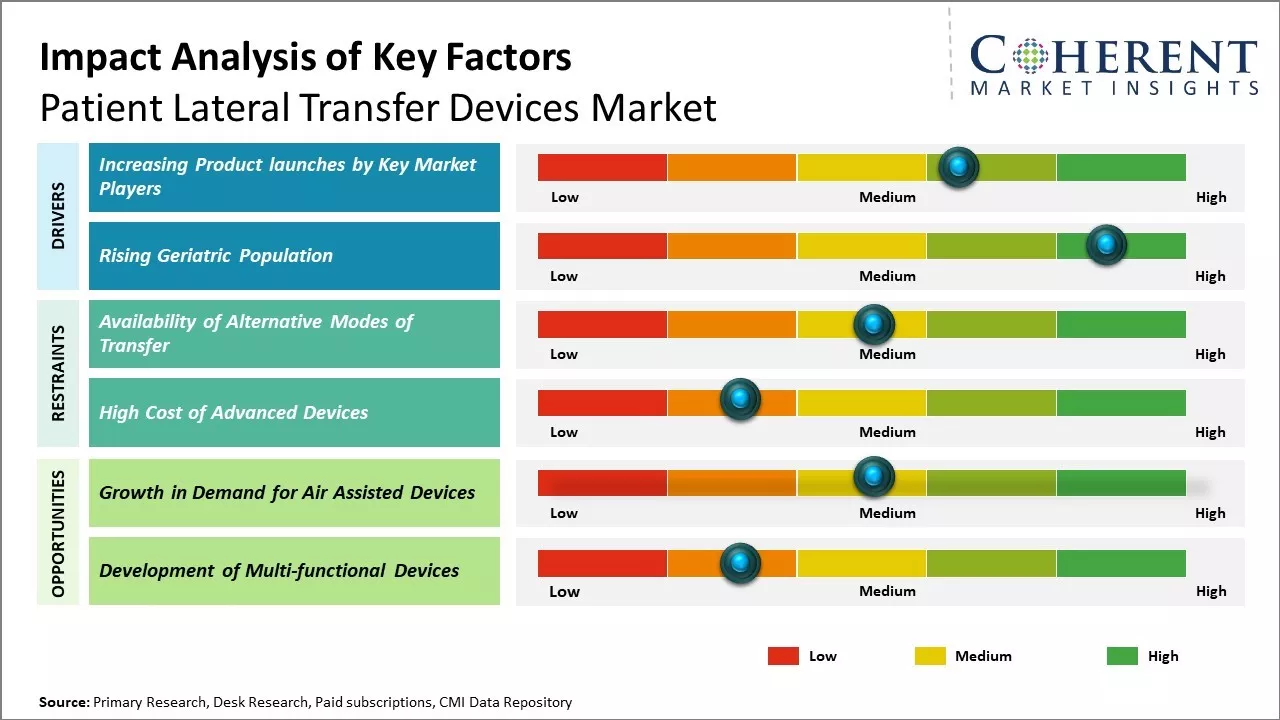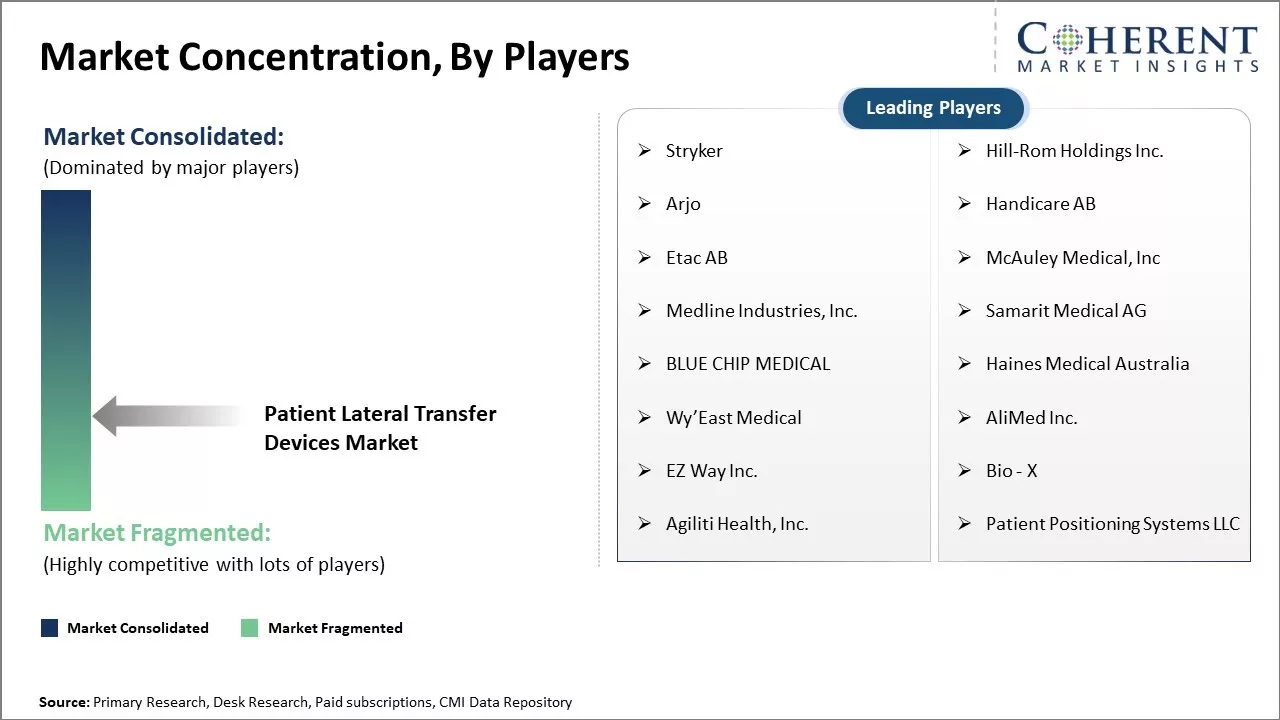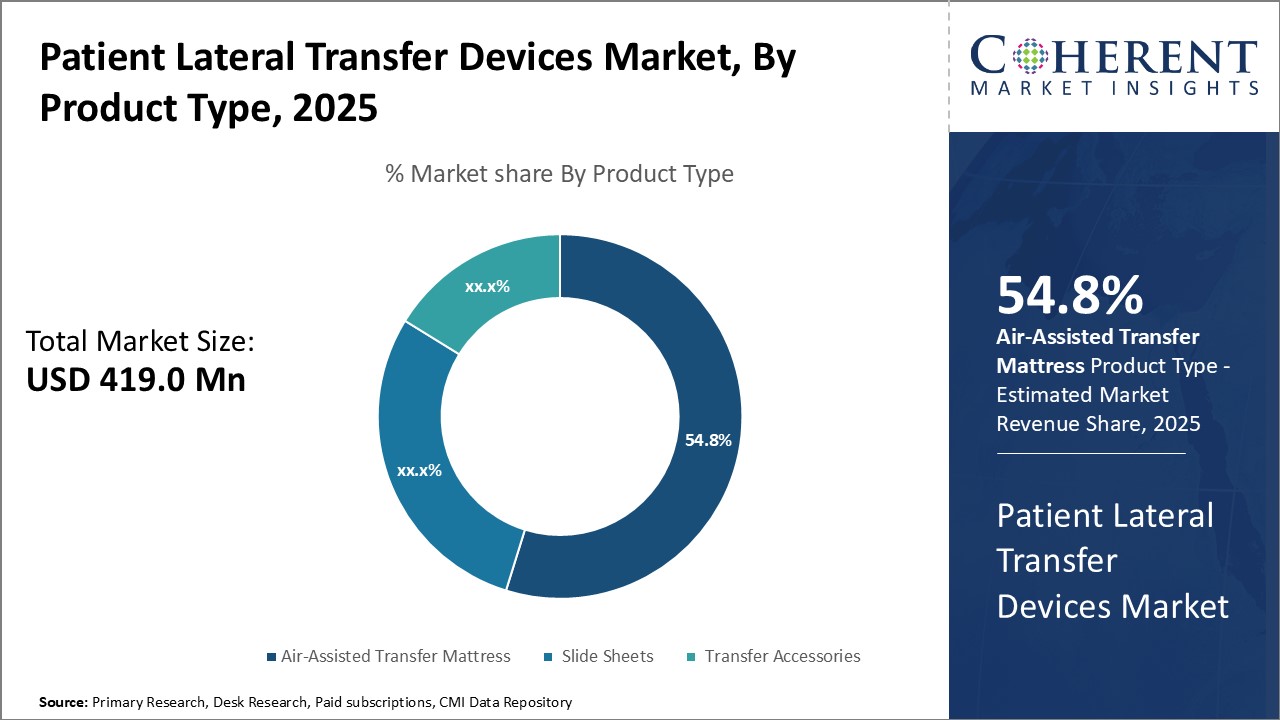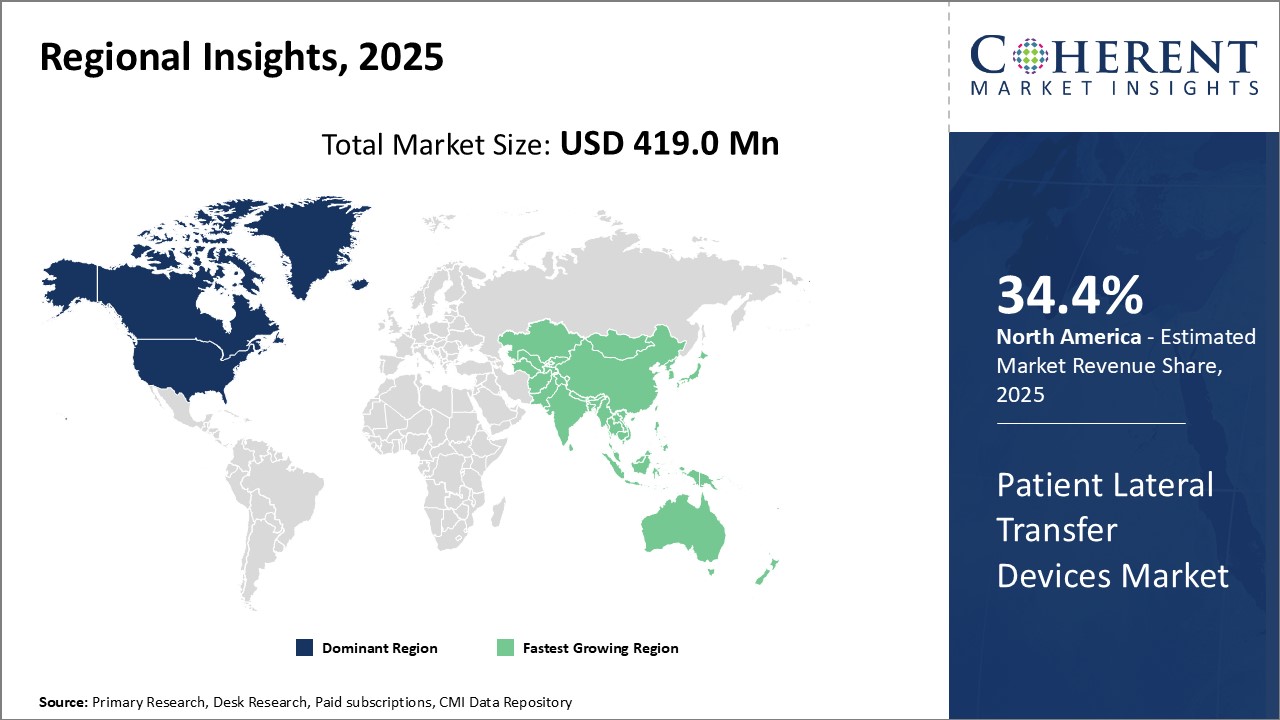Global patient lateral transfer devices market is estimated to be valued at USD 419.0 Mn in 2025 and is expected to reach USD 838.1 Mn by 2032, exhibiting a compound annual growth rate (CAGR) of 10.4% from 2025 to 2032.

Discover market dynamics shaping the industry: Request sample copy
The global patient lateral transfer devices market is witnessing positive trends with growing geriatric population being more susceptible to chronic illnesses and injuries requiring long term care. This is increasing the demand for patient transfers from beds, wheelchairs, or imaging tables safely and efficiently. Furthermore, the implementation of regulations by various countries emphasizing on ergonomic safety of caregivers during manual patient handling is promoting the adoption of lateral transfer devices. However, high costs of equipped transfers and limited reimbursements in some regions may hinder the market growth to a certain extent over the forecast period.
Increasing Product launches by Key Market Players
Increasing product launches by key market players are expected to drive the market growth over the forecast period. For instance, in September 2023, Pelstar LLC, a manufacturer of medical devices, announced the launch of BridgeAir, a new Breathable air-assisted lateral transfer and repositioning mattress. Bridge Healthcare’s BridgeAir was designed to prioritize the well-being of caregivers, patients, and healthcare organizations.

Get actionable strategies to beat competition: Request sample copy
Rising Geriatric PopulationThe global geriatric population is growing at an unprecedented rate. According to the World Health Organization (WHO), the number of people aged 65 years and above is projected to grow from an estimated 524 million in 2010 to nearly 1.5 billion in 2050. As people age, their risk of developing chronic illnesses and disabilities increases dramatically. Falls are one of the leading causes of injury among the elderly and often result in fractures, head injuries, or other serious physical trauma. Patient lateral transfer devices play a crucial role in facilitating the safe movement and transportation of geriatric patients, especially those recovering from injury or surgery. These devices help caregivers transfer patients between beds, wheelchairs, stretchers, and other surfaces without requiring strenuous lifting or excessive physical exertion. With increasing longevity worldwide, the geriatric population will continue expanding in the coming decades.
Key Takeaways of Analyst
The global patient lateral transfer devices market is expected to witness steady growth over the forecast period driven by the rising geriatric population and increasing incidence of chronic diseases. The increasing number of hospitals and ambulatory surgical centers worldwide will also contribute to the growing demand for these medical devices. However, the high costs associated with technologically advanced lateral transfer devices may hamper market growth to some extent.
North America is anticipated to dominate the market during the projected timeframe owing to the well-established healthcare infrastructure and rising healthcare spending in the region. Within North America, the U.S. accounts for the major share due to the presence of advanced medical facilities. Europe will emerge as another lucrative market supported by the increasing number of surgical procedures and the growing focus on patient safety.
The patient lateral transfer devices market is likely to shift towards emerging economies such as Asia Pacific and Latin America. This can be attributed to improving healthcare infrastructure, expanding patient pool, and rising medical tourism across Asia Pacific countries like China and India. Meanwhile, medical device manufacturers should capitalize on the opportunities arising from unmet needs in developing Latin American countries.
Market Challenge – Availability of Alternative Modes of Transfer
The availability of alternative modes of patient transfer is significantly restraining the growth of the global patient lateral transfer devices market. Patients and caregivers now have viable substitutes to lateral transfer devices that allow for smoother and less invasive transfer of patients. The growing prominence and access to these air-assisted and slide sheet alternatives to traditional lateral transfer devices has begun to curtail the growth potential of the conventional device market. Whereas air-driven mattresses and advanced slide sheets address key issues like injury prevention, patient comfort, and hygiene in a more effective manner compared to basic drawsheets and boards. This creates substantial challenges for lateral transfer device manufacturers to differentiate their offerings. Unless these companies are able to develop novel innovations that render their products superior substitutes over the available alternatives, the market may experience flatter growth over the coming years.
Market Opportunity – Growth in Demand for Air Assisted Devices
The demand for air assisted lateral transfer devices is growing significantly across healthcare facilities globally. Air assisted devices rely on an air-powered system to gently slide patients from one surface to another, reducing manual handling and risk of injuries for caregivers. They are especially useful for bariatric and disabled patients who are difficult to move. As the incidence of obesity, accidents and lifestyle diseases rise worldwide, the need for safe and effortless transfers is increasing rapidly. The rising global demand opens up vast opportunities for manufacturers of air assisted lateral transfer devices. Market leaders need to work on expanding production capacities and distribution networks to cater to the growing needs of hospitals, clinics and long-term care establishments. Developing low-cost options for budget-conscious markets can also help companies target wider customer segments. With a favorable regulatory environment supporting workplace safety, this domain is projected to remain a lucrative segment of the patient handling equipment industry globally over the next decade.

Discover high revenue pocket segments and roadmap to it: Request sample copy
Insights, By Product Type: Convenience drives growth in the oral segmentProduct type segment is sub-segmented into air-assisted transfer mattress, slide sheets, and transfer accessories. The air-assisted transfer mattress segment is estimated to hold 54.8% of the market share in 2025, owing to their comfort and safety benefits over alternative options. These mattresses are filled with air cells that can be inflated or deflated according to the needs of the patient transfer process. This allows caregivers to easily mold the mattress into any shape required to securely hold the patient without causing unnecessary stress or pain. The cushioning effect of the air cells distributes the patient's weight evenly for enhanced comfort and reduces the risk of bed sores or skin irritation. Air cells can also be depressed selectively on either end to achieve a sloping surface, facilitating easy lateral shifting of patients intra-hospital. Further, the lightly suspended feel of air-assisted transfer mattresses minimizes friction between the patient's body and the transfer equipment. This enhances safety as it lowers the chances of accidental slips or falls that could potentially lead to injuries. Some advanced models are equipped with inflatable side bolsters that can be activated with the touch of a button to safeguard patients from falls. Overall, the unique design characteristics of air-assisted transfer mattresses address the priorities of comfort and safety most effectively among lateral transfer devices. This differentiates them from alternatives and drives their top position in the global market.
Insights, By Usage: Reusability enhances value proposition of reusable patient lateral transfer products
Usage segment is sub-segmented into reusable patient lateral transfer products and single-use patient lateral transfer products. The reusable patient lateral transfer products segment is estimated to hold 55.2% of the market share in 2025 owing to their superior value and reuse potential over single-use options. Reusable products like slide sheets and lifting belts are constructed with durable medical-grade materials that can withstand multiple cleanings and sterilization cycles between patients. This allows facilities to significantly lower the total cost of ownership compared to repeatedly purchasing disposable equivalents. It also helps reduce waste generation that is a growing concern for the healthcare industry. Most reusable devices are compatible with all major brands of beds, stretchers, and transfer equipment as well. This interchangeability maximizes usage rates per product unit. They can simply be machine washed with hospital-approved disinfectants, inspected, and kept ready for the next use. Some high-end reusable products now also offer antimicrobial coatings that make them highly resistant to germs and streamline reprocessing. Overall, the value and eco-friendliness propositions around reuse have made reusable lateral transfer products the treatment of choice among healthcare providers seeking cost-efficiency and sustainability.
Insights, By End User: Prevalence of chronic diseases drives demand in hospitals
End user segment is sub-segmented into hospitals, ambulatory surgical centers, and others. The hospitals segment is estimated to hold 35.1% of the market share in 2025 due to the growing prevalence of age-related chronic illnesses and mobility impairments that often require multi-departmental and long-term care within hospitals. Conditions like diabetes, cardiovascular disease, obesity, and musculoskeletal disorders are steadily rising worldwide. Advanced age further deteriorates motor control and bodily functions, increasing the risk of falls or injury during movement. Hospitals consequently see high volumes of patients needing assistance with activities of daily living including lateral transfers between beds, stretchers, diagnostic tables, and operation theaters.

Need a Different Region or Segment? Customize now
North America remains the dominant region in the global patient lateral transfer devices market and is estimated to hold 34.4% of the market share in 2025 due to a strong healthcare infrastructure and high healthcare spending across major countries like the U.S. The presence of most global leaders in the medical devices industry such as Stryker, Hill-Rom, and Arjo have helped boost the adoption of safe patient transfer devices in clinical settings. In addition, favorable reimbursement policies backed by private and public insurance payers have made lateral transfer equipment accessible to a wide range of care providers.
The Asia Pacific region is emerging as the fastest growing market for patient lateral transfer devices. Countries like China, India, Japan, and South Korea are witnessing exponential growth in the geriatric population coupled with the rising prevalence of chronic diseases. This has significantly increased the burden on healthcare systems. In response, governments across Asia Pacific are investing heavily to modernize hospitals and nursing homes with latest medical technologies. This includes replacing outdated patient transfer aids with ergonomic lateral transfer equipment. The export of patient lateral transfer devices from major Asia Pacific countries like China and India is also on the rise. Their ability to produce high-quality cost-effective products has enabled them gain a strong foothold in price-sensitive developing markets of Middle East, Africa, and Latin America. Additionally, global medical device giants are shifting their low-cost device manufacturing base to Asia Pacific in order to reduce production costs. Their increasing regional presence through partnerships with local players will augment supply and access to lateral transfer devices across Asia Pacific in the coming years.
Patient Lateral Transfer Devices Market Report Coverage
| Report Coverage | Details | ||
|---|---|---|---|
| Base Year: | 2024 | Market Size in 2025: | USD 419.0 Mn |
| Historical Data for: | 2020 To 2024 | Forecast Period: | 2025 To 2032 |
| Forecast Period 2025 to 2032 CAGR: | 10.4% | 2032 Value Projection: | USD 838.1 Mn |
| Geographies covered: |
|
||
| Segments covered: |
|
||
| Companies covered: |
Stryker, Hill-Rom Holdings Inc., Arjo, Handicare AB, Etac AB, McAuley Medical, Inc, Medline Industries, Inc., Samarit Medical AG, BLUE CHIP MEDICAL, Haines Medical Australia, Wy’East Medical, AliMed Inc., EZ Way Inc., Bio - X, Agiliti Health, Inc., and Patient Positioning Systems LLC |
||
| Growth Drivers: |
|
||
| Restraints & Challenges: |
|
||
Uncover macros and micros vetted on 75+ parameters: Get instant access to report
*Definition: Patient lateral transfer devices are used to shift a patient from one surface to another surface, i.e., shifting a patient from a bed to stretcher, bed to wheel chair, etc. Shifting a patient from one place to another can cause an injury to caregivers. Hence, varieties of patient lateral transfer devices are available in the market for shifting patients, such as draw sheets, slide sheets, transfer belts/ slide boards, turning disks, etc. These products can be used based on the condition of the patient.
Share
Share
About Author
Komal Dighe is a Management Consultant with over 8 years of experience in market research and consulting. She excels in managing and delivering high-quality insights and solutions in Health-tech Consulting reports. Her expertise encompasses conducting both primary and secondary research, effectively addressing client requirements, and excelling in market estimation and forecast. Her comprehensive approach ensures that clients receive thorough and accurate analyses, enabling them to make informed decisions and capitalize on market opportunities.
Missing comfort of reading report in your local language? Find your preferred language :
Transform your Strategy with Exclusive Trending Reports :
Frequently Asked Questions
Joining thousands of companies around the world committed to making the Excellent Business Solutions.
View All Our Clients
US Reciprocal Tax Impact Analysis On Patient Lateral Transfer Devices Market
Stay updated on tariff changes with expert insights and timely information